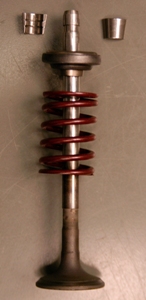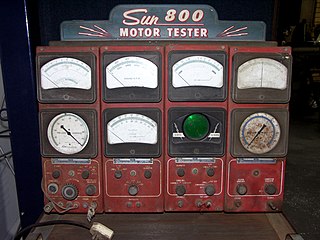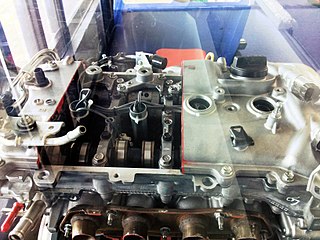
A poppet valve is a valve typically used to control the timing and quantity of gas or vapour flow into an engine.

A four-strokeengine is an internal combustion (IC) engine in which the piston completes four separate strokes while turning the crankshaft. A stroke refers to the full travel of the piston along the cylinder, in either direction. The four separate strokes are termed:
- Intake: Also known as induction or suction. This stroke of the piston begins at top dead center (T.D.C.) and ends at bottom dead center (B.D.C.). In this stroke the intake valve must be in the open position while the piston pulls an air-fuel mixture into the cylinder by producing vacuum pressure into the cylinder through its downward motion. The piston is moving down as air is being sucked in by the downward motion against the piston.
- Compression: This stroke begins at B.D.C, or just at the end of the suction stroke, and ends at T.D.C. In this stroke the piston compresses the air-fuel mixture in preparation for ignition during the power stroke (below). Both the intake and exhaust valves are closed during this stage.
- Combustion: Also known as power or ignition. This is the start of the second revolution of the four stroke cycle. At this point the crankshaft has completed a full 360 degree revolution. While the piston is at T.D.C. the compressed air-fuel mixture is ignited by a spark plug or by heat generated by high compression, forcefully returning the piston to B.D.C. This stroke produces mechanical work from the engine to turn the crankshaft.
- Exhaust: Also known as outlet. During the exhaust stroke, the piston, once again, returns from B.D.C. to T.D.C. while the exhaust valve is open. This action expels the spent air-fuel mixture through the exhaust valve.

Engine tuning is the adjustment or modification of the internal combustion engine or Engine Control Unit (ECU) to yield optimal performance and increase the engine's power output, economy, or durability. These goals may be mutually exclusive; an engine may be de-tuned with respect to output power in exchange for better economy or longer engine life due to lessened stress on engine components.
VTEC is a system developed by Honda to improve the volumetric efficiency of a four-stroke internal combustion engine, resulting in higher performance at high RPM, and lower fuel consumption at low RPM. The VTEC system uses two camshaft profiles and hydraulically selects between profiles. It was invented by Honda engineer Ikuo Kajitani. It is distinctly different from standard VVT systems which change only the valve timings and do not change the camshaft profile or valve lift in any way.

In internal combustion engines, variable valve timing (VVT) is the process of altering the timing of a valve lift event, and is often used to improve performance, fuel economy or emissions. It is increasingly being used in combination with variable valve lift systems. There are many ways in which this can be achieved, ranging from mechanical devices to electro-hydraulic and camless systems. Increasingly strict emissions regulations are causing many automotive manufacturers to use VVT systems.

VVT-i, or Variable Valve Timing with intelligence, is an automobile variable valve timing technology developed by Toyota. The Toyota VVT-i system replaces the Toyota VVT offered starting in 1991 on the 5-valve per cylinder 4A-GE engine. The VVT system is a 2-stage hydraulically controlled cam phasing system.
VarioCam is an automobile variable valve timing technology developed by Porsche. VarioCam varies the timing of the intake valves by adjusting the tension on the timing chain connecting the intake and exhaust camshafts. VarioCam was first used on the 1992 3.0 L engine in the Porsche 968.

MIVEC is the brand name of a variable valve timing (VVT) engine technology developed by Mitsubishi Motors. MIVEC, as with other similar systems, varies the timing of the intake and exhaust camshafts which increases the power and torque output over a broad engine speed range while also being able to help spool a turbocharger more quickly and accurately.
The active valve control system (AVCS) is an automobile variable valve timing technology used by Subaru. It varies the timing of the valves by using hydraulic oil pressure to rotate the camshaft, known as "phasing", in order to provide optimal valve timing for engine load conditions. The system is closed loop using the camshaft sensors, crankshaft sensors, air flow meter, throttle position as well as oxygen sensors and/or Air-Fuel ratio sensors in order to calculate engine load. The ECU is programmed to operate control valves that adjust the delivery of the hydraulic pressure in order to move the camshaft into the position that will provide the engine with the best performance while meeting emissions standards.

An overhead valve engine, or pushrod engine, is a reciprocating piston engine whose poppet valves are situated in the cylinder head. An OHV engine's valvetrain operates its valves via a camshaft within the cylinder block, cam followers, pushrods, and rocker arms.

In automotive engineering, an inlet manifold or intake manifold is the part of an engine that supplies the fuel/air mixture to the cylinders. The word manifold comes from the Old English word manigfeald and refers to the multiplying of one (pipe) into many.

Alfa Romeo Twin Spark (TS) technology was used for the first time in the Alfa Romeo Grand Prix car in 1914. In the early 1960s it was used in their race cars to enable it to achieve a higher power output from its engines. And in the early and middle 1980s, Alfa Romeo incorporated this technology into their road cars to enhance their performance and to comply with stricter emission controls.

The Honda K-series engine is a line of four-cylinder four-stroke car engine introduced in 2001. The K-series engines are equipped with DOHC valvetrains and use roller rockers to reduce friction. The engines use a coil-on-plug, distributorless ignition system with a coil for each spark plug. This system forgoes the use of a conventional distributor-based ignition timing system in favor of a computer-controlled system that allows the ECU to control ignition timings based on various sensor inputs. The cylinders have cast iron sleeves similar to the B- and F-series engines, as opposed to the FRM cylinders found in the H- and newer F-series engines found only in the Honda S2000.
Valve float is an adverse condition which can occur at high engine speeds when the poppet valves in an internal combustion engine valvetrain do not properly follow the closure phase of the cam lobe profile. This reduces engine efficiency and performance and potentially increases engine emissions. There is also a significant risk of severe engine damage due to valve spring damage and/or pistons contacting the valves.

A rocker arm is an oscillating lever that conveys radial movement from the cam lobe into linear movement at the poppet valve to open it. One end is raised and lowered by a rotating lobe of the camshaft while the other end acts on the valve stem. When the camshaft lobe raises the outside of the arm, the inside presses down on the valve stem, opening the valve. When the outside of the arm is permitted to return due to the camshafts rotation, the inside rises, allowing the valve spring to close the valve.
The cam-in-block valvetrain layout of piston engines is one where the camshaft is placed within the cylinder block, usually beside and slightly above the crankshaft in a straight engine or directly above the crankshaft in the V of a V engine. This contrasts with an overhead camshaft (OHC) design which places the camshafts within the cylinder head and drives the valves directly or through short rocker arms.
A helical camshaft is a type of mechanical variable valve actuation (VVA) system. More specifically it is a camshaft that allows the valve opening duration to be varied over a wide, continuous, step-less range, with all of the added duration being at full valve lift.
Advanced VTEC is a system designed to allow the variation of valve timing and lift. It is designed to improve engine Fuel efficiency without sacrificing performance. It is an evolution of a long line of VTEC systems from Honda.
Variable valve lift (VVL) is an automotive piston engine technology which varies the height a valve opens in order to improve performance, fuel economy or emissions. There are two main types of VVL: discrete, which employs fixed valve lift amounts, and continuous, which is able to vary the amount of lift. Continuous valve lift systems typically allow for the elimination of the throttle valve.












